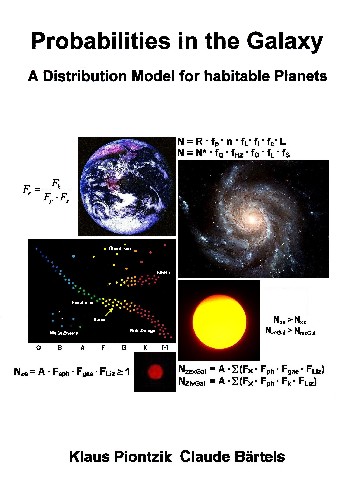There are 8 components necessary to make life possible
and develop, with all its possibilities. This can also
cause 8 failures. Thus, the chance of life arises 1 to 9.
That corresponds to a share of 11.11%.
The probability factor is therefore FL
= 0.111 = 1:9.
Further developed, from equation 3.1.1 results for the
number NLe
animated "earth 2" in sun-like systems
:
| 4.2.1 Equation |
NLe
= Nhe ·
FL
NLe
= A · Fsph ·
Fgae ·
FL
NLe
= A · Fs ·
Fp ·
Fh ·
Fg ·
Fa ·
Fe ·
FL |
|
Since two values exist for Fe or Fgae
a minimum-maximum statement can also be generated here:
Inserting all values (Fe = 0.1) into equation
4.2.1:
NLe1 = (100-300)·109 · 1:15,000
· 1:69 · 1:9
NLe1
= 10,735 – 32,206 habitable „Earth 2" with
life
Inserting all values (Fe = 0.01) into equation
4.2.1:
NLe2 = (100-300)·109 · 1:15,000
· 1:691 · 1:9
NLe2
= 1,072 – 3,216 habitable „Earth 2" with
life
The two results can then be summarized to the following
statement:
| 4.2.2 Theorem |
The number of solar-like
star systems, with a habitable "Earth
2" in the galaxy, which could carry life, is
probably 1,072 to 32,206. |
The probability for an "Earth 2" with life, in
a sun-like star system, in our galaxy, is then:
| 4.2.3 Definition |
FLe
= Fs ·
Fp ·
Fh
· Fg
· Fa
· Fe ·
FL
FLe
= Fsph
· Fgae
· FL |
FLe = Fsph·Fgae·FL
FLe= 1:15,000 · (1:69 - 1:691) · 1:9
FLe= 1:9,315,000 – 93,285,000
Only every 9.315 - 93.285 millionth star
system then has an earth-like, animated planet.
|

